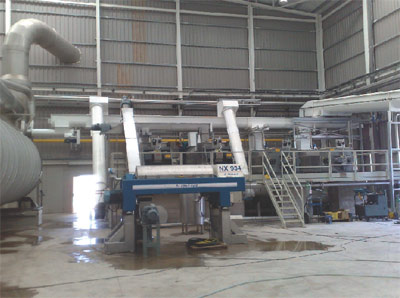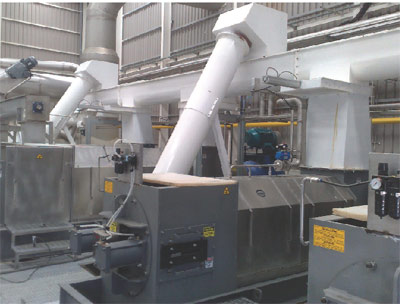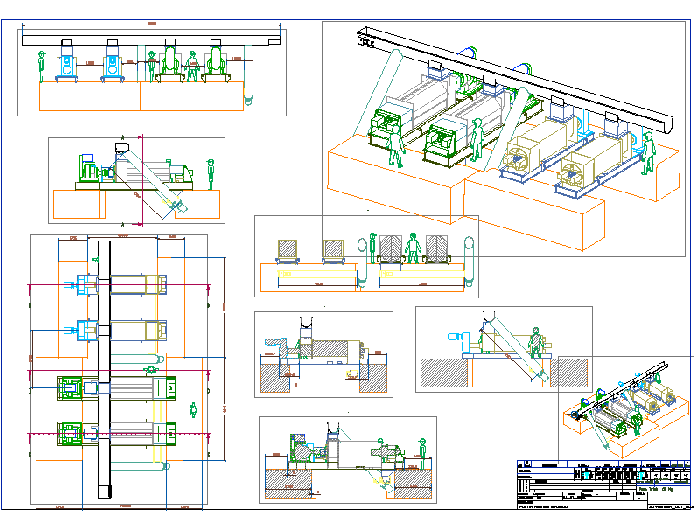ZUVAMESA with a 50 WHE was €8M, while CITROTECNO was €12M, each plus 18% VAT. The CITROTECNO feedmill with a 40 WHE was €7-7-1/2M; the rest was for the ethanol plant.”
The CITROTECNO project is rated for 25-30 MTPH of citrus waste. The waste comes from several citrus processors in the area as well as packing houses. An ethanol plant at the site, using de-oiled and pasteurized press liquor, is entering the start-up stage.
Both local and national government entities have given financial support to the operation.
The ZUVAMESA project is rated for 50 MTPH. [Actual performance reached 75 MTPH.] The waste comes from a juice extraction plant at the same site. The company is owned by several hundred citrus growers in the area. The local government has provided financial support.
The two feedmills are quite similar. Both feature the use of a Waste Heat Evaporator (WHE) to achieve high thermal efficiency. These WHE’s are a three effect, vertical tube, falling fill design. In the construction 304 stainless is used for vapor and water components while product contact is in 316L. Durco pumps, imported from the States, were selected for their known reliability.
Single pass rotary drum dryers, standard of the citrus industry, are employed. The CITROTECNO unit, rated at 30,000 pph of water evaporation, is paired with a 40,000 pph WHE. At ZUVAMESA at 40,000 pph dryer is paired with a 50,000 pph WHE.
The dryers and WHE’s were designed and constructed by FOMESA.
Both feedmills feature double pressing with Vincent screw presses with 24″ diameter screws. First pressing is done with a low torque Series KP press, while second pressing is done with a high torque Series VP press. All presses use 50 hp motors.
The flexibility offered by double pressing has been advantageous where spoiled fruit is being processed. This is quite common at CITROTECNO.
During start up a great deal of difficulty was encountered with the high viscosity and insoluble fiber content of the press liquor. There is something different, possibly in the firmness, about this Mediterranean fruit as compared to fruit in Brazil and Florida. As at FMC’s Parmalat job in Sicily, it was necessary to add centrifuges to remove fiber from the press liquor. Only after this was done was satisfactory WHE performance achieved.
Both WHE’s produce 45 Brix molasses on a consistent basis. A 24 hour cleaning cycle is used. An Alfa Laval centrifuge is used at ZUVAMESA while the unit at CITROTECNO is a GEA WESTFALIA.
The shredders feature hammers made of Duplex stainless steel, which is proving exceptionally durable. The inlet housings are square, an innovation first introduced by Tegreene in Florida. The blades are 180 degrees apart, and innovation introduced by CORENCO. The discharge screens are exceptionally thick, 5/8″, with square round holes.
The reaction conveyors are sized for 15 minutes reaction time, with 0.5% hydrated lime addition. Inclined units are used to elevate the peel from the peel bin up to above the screw presses. These use slow turning 24″ diameter screw conveyors with half pitch flighting.
Pellet mills supplied by Van Aarsen are used at both feedmills. These produce excellent pellets with a minimum of difficulty.
ADDENDUM: The CITROTECNO ethanol plant made 14,000 l of 90% ethanol the first season. They run on press liquor which is pasteurized at 90 C. They pump it to a flash tank to remove the d-limonene. When they had no press liquor, they kept the alcohol plant running by diluting molasses to 15-20 Bx.”
Vincent Corporation is proud to have played an important role in the success of these feedmills.



The photos and layout drawing show how Zuvamesa does first pressing with two Model KP-24 presses, and then second pressing with two VP-24’s. After that the press cake goes to the dryer. In the photos the two KP-24’s are on the right hand side, and the dryer is off to the left. You can see that they used screw conveyors to lift the cake up into a horizontal screw conveyor which runs from right to left. The peel comes into this conveyor on the right hand side. The peel can then fall into the two KP-24’s, or it can by-pass to the two VP-24’s, or it can by-pass all four presses and go to the dryer.
The cake from the two KP-24’s is elevated in a screw conveyor which has a circular (cylindrical) trough; it is mounted at about 60 degrees. Similarly, the cake from the two VP-24’s is elevated in a screw conveyor which has a circular (cylindrical) trough; it is mounted at about 60 degrees. The cake coming up in these two elevating conveyors drops into the long horizontal conveyor which runs from the far right to the dryer at the far left.
This is a very effective system of double pressing.
